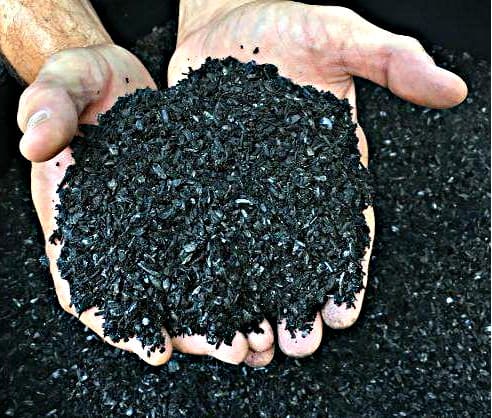What is biochar? When I first heard of this amazing soil amendment, I was very skeptical. How could charcoal help improve my soil? How could I use it in the garden? And how can I make it at home without any special equipment? All these things and more I have learned about in the last 5 years, since first hearing about biochar at a seminar in Kansas City.
Biochar is a type of charcoal made from plant materials and wood. Unlike the material we use in our grills, biochar is ground up and inoculated with microbials and nutrients, then used in the garden and landscape.
Benefits of Biochar in the Garden
Besides having the knowledge of what it is, you need to know where in the garden to use biochar. It is not like other soil amendments, in that it has to be produced, either on or off site, before being added to the soil. But what are the benefits?
- It remains intact for decades if not centuries, in the soil strata
- Because it remains intact, it improves aeration and soil water-holding ability
- It provides a home for bacteria, fungi, and other soil micro-organisms, which improve soil
- Binds heavy metals, releasing bound plant nutrients at the same time.
- Locks up carbon in the soil, reducing atmospheric CO2
- Can raise the pH of soil (this could be a detractor in vegetable gardens, where many plants need a lower pH to perform best)
- Raise the heat holding ability of some soils for earlier spring planting.
How do Microorganisms in the Soil Work with Biochar
There micropores on the surface of the individual particles of biochar, which are good hiding places for microorganisms. Organisms such as fungi and bacteria play and important role in a plant’s ability to take up valuable nutrients. Since biochar not only houses these organisms, but ties up heavy metals which are binding plant nutrients, it has a double benefit to plant growth.

You can find more about microorganisms in the soil the in the book: Teaming with Microbes by Jeff Lowenfels & Wayne Lewis.
How can it Raise the Heat Holding Ability of the Soil?
Because biochar is black or very dark in color, when it is ground to a grain size material and mixed into the soil, it turns the soil dark. This has been done in the past using ash from chimney pots. The now darker soil is able to absorb heat better, and may allow for the soil to warm up quicker in the spring. This means earlier planting times for some vegetables.
Should I Buy or Make My Own Biochar?
This is a difficult question to ask. It is expensive to buy as a soil amendment, but time consuming if making it at home. Let us look at buying pros and cons first.
Benefits and Detractions of Buying Biochar
Like I said, it is expensive. A 1 cubic foot bag may cost between $20 and $50, depending on the manufacturer and location being shipped from. That bag, in turn, covers approximately 375 square feet, which is a 10 foot by 37.5 foot bed. That sounds like it covers a lot, but many gardeners have multiple beds, and turf as well, that they may want to use it on. It adds up quickly.
On the other hand, commercially produced biochar has already done all your time consuming work. You do not need to worry about getting your fire just right, about oxygen levels of your fire or kiln, or activating it. You can just buy it and apply it.
One other con of buying biochar versus making it, is the affect you are having on your own environment. Commercially produced charcoals often do not recycle or use available materials, but bring in wood or manure from out of state locations. This is not environmentally responsible. If you make your own, then you will always know the source of materials.
Pros and Cons of Making Your Own Biochar
Making your own biochar is not as hard as it sounds. You do not need an oven, or a kiln. Just and open pit will and a covering will be enough. The covering for the pit should have a small hole to allow a small amount of oxygen in, but otherwise smother the fire. By producing it yourself, you can recycle waste products from your own landscape or farm.
However, you may not be able to make it in your own backyard. If you live in an HOA or inside city limits, you may be limited on the type of bonfires you can create in your yard. Also, activating your own biochar may be more time intensive then you want to do.
What does Activation Involve?
When biochar is first produced, it is devoid of nutrients and may act as a sponge, soaking up nutrients from the soil. Thus, it needs to be charged or activated before adding to the soil. This can be done several ways.
- Steeping it in urine for up to 6 weeks
- Mixing it 50:50 with worm castings and 5% flour and leaving to sit for 2 weeks
- Mixing 50:50 with grass clippings, covering, and letting sit for 3 months
- Adding it to compost as the compost is being made (my way)
- Mixing with aerobically produced manure tea

Making My Own Biochar
Producing biochar on a micro-scale at home and mixing it with compost to activate it is the way I prefer to produce it. I have an abundance of tree cuttings, cow, chicken, and goat manures, and leaves that I use for both. The best method for small-scale production is a pit method, because I can control the size of fire and not waste water for putting it out.
This video will help you discover how to build a pit and make your own biochar at home. Finally Making Biochar
Conclusion
Biochar is not the hard to make thing many of us wondered about when we first saw it in the garden center. Rather, it can be easy to make and use in the garden. We can produce this beneficial soil amendment and watch our gardens grow.
Happy planting!





Thanks for this amazing blog. It really helped me to understand the Gardening with biochar.